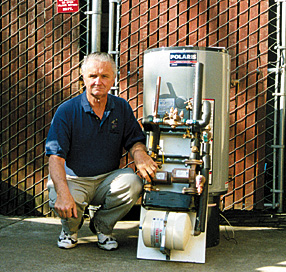Water Heaters And Radiant Heat

OK, I'm exaggerating. The use of water heaters in radiant heating applications has its detractors, but there are a growing number of radiant heating plumbers who believe in the concept.
One of the most vocal believers is Bill Clinton, owner and operator of Sonoma, Calif.-based Bay Hydronics. He says the three main reasons to use a water heater for space heating are: 1) it can operate with any return temperature, 2) there are no concerns about flow rate, and 3) increased efficiency.
Boiler systems are typically designed for a water temperature of 180 degrees F or higher -- too hot for radiant floor applications, Clinton says. Water heaters, however, have water temps in the 110-degree F to 140-degree F range -- perfect for radiant floors, baseboard and panel radiator applications. And water heaters can handle low flow rates and incoming water temperatures of 55 degrees F. These same conditions can crack or rupture a boiler, he says.
Typically water heaters have standby losses (heat wasted up the chimney), resulting in low energy efficiency. By adding a radiant heat function, that loss is eliminated and the efficiency of the unit is increased, he explains.
The Combo Advantage
Most water heaters today are certified for combination use -- space heating and potable water, Clinton says. But combination water heaters have one additional advantage, explains Jim McGoldrick, product manager for Bradford White: saving space."Combination units, like our CombiCor, have the same footprint as a conventional water heater," he explains. "It's a space-saving design that provides the proper heat for domestic hot water and radiant systems. In fact, the CombiCor is specifically designed for in-floor radiant heating."
Doug Dodds, vice president of sales at Triangle Tube/Phase III, agrees: "Mechanical rooms are smaller today, so a boiler/water heater system may be difficult to install. Most boilers have some sort of clearance required; our new Delta Performance is rated for zero clearance, so it could be installed in a closet if needed."
These combination systems are be-coming more popular because the installation is less time-consuming, he adds.
Health Concerns
Using a water heater for space heating naturally produces water too hot for bathing or laundry, so an anti-scald tempering valve must also be installed. The tempering valve mixes the outgoing water with cold line water, thus lowering the overall temperature.But the most concern seems to be leveled at the possibility of bacteria growth. There is some debate on the subject, with many believing that water heaters pose no real threat of producing dangerous bacteria such as Legionellae.
Others, such as Bill Clinton, believe there is a danger, and have identified ways to minimize the problem. "There's about a 10 percent chance that the others are wrong," he says. "I recommend using a heat exchanger to separate the potable water from the space-heating water to reduce the growth of harmful bacteria."
Plastic piping supports biofilm, he adds, which serves as food for bacteria.
Gas water heaters seem to be less likely to have Legionellae than electric water heaters (see "Preventing Legionella In Home Plumbing Systems," Plumbing & Mechanical, January 2002). The heat source for gas heaters is below the water tank, keeping the entire tank hot enough to prevent bacteria growth. Electric water heaters usually have heat sources on the side of the tank, leaving the water in the bottom cool.
The Radiant Panel Association has set up standards endorsing the use of heat exchangers with water heaters for hydronic/domestic applications.
Both the CombiCor and the Delta Performance keep potable water and space-heating water separate. The CombiCor uses a built-in heat exchanger immersed in the tank; the Performance is a tank-within-a-tank system.
While water heaters may not be the best space-heating solution in all cases, their use will continue to grow, Clinton says.
Looking for a reprint of this article?
From high-res PDFs to custom plaques, order your copy today!






